Answered step by step
Verified Expert Solution
Question
1 Approved Answer
e of (Click on the icon here in order to copy the contents of the data table below into a spreadsheet.) prod het w flow
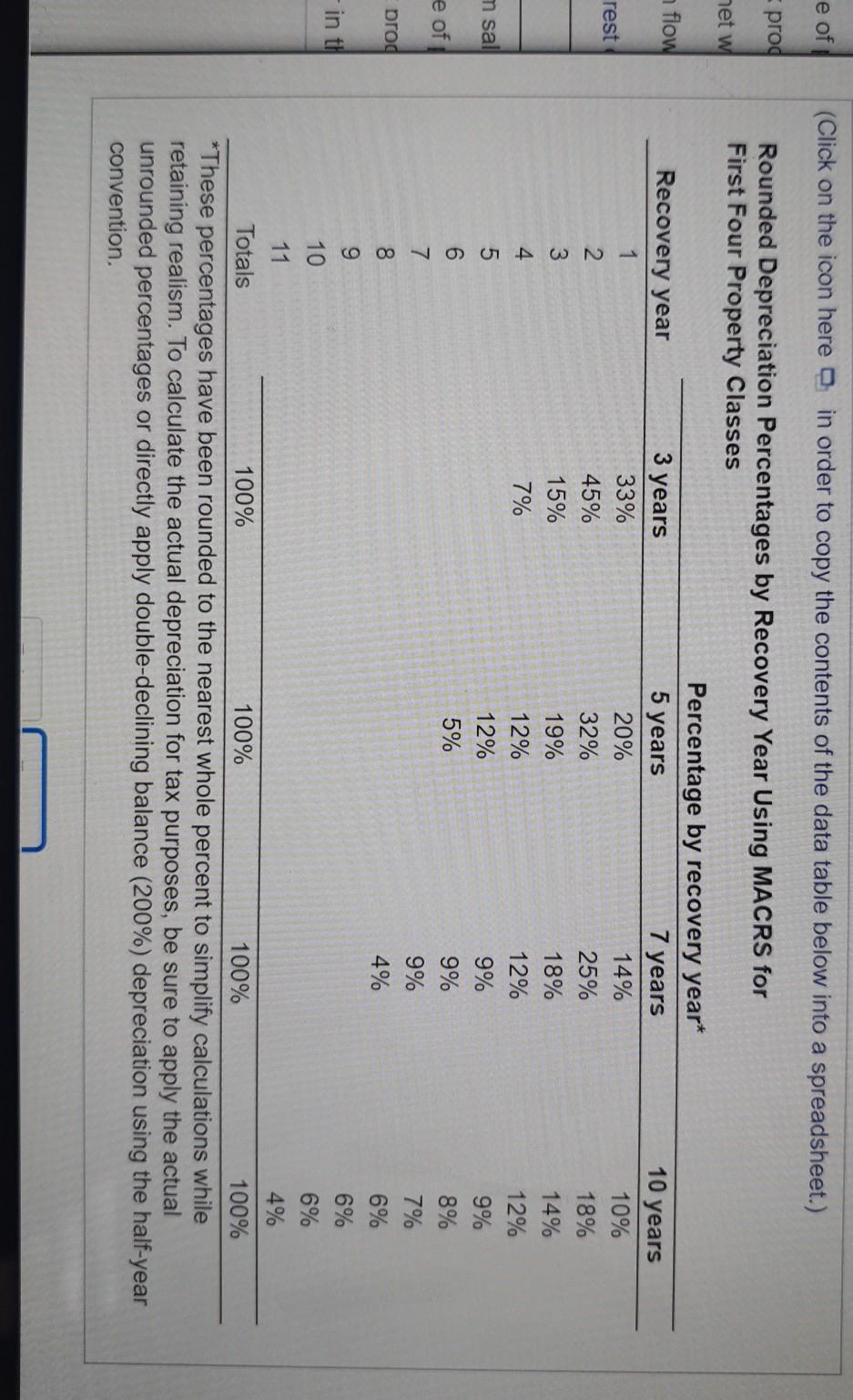
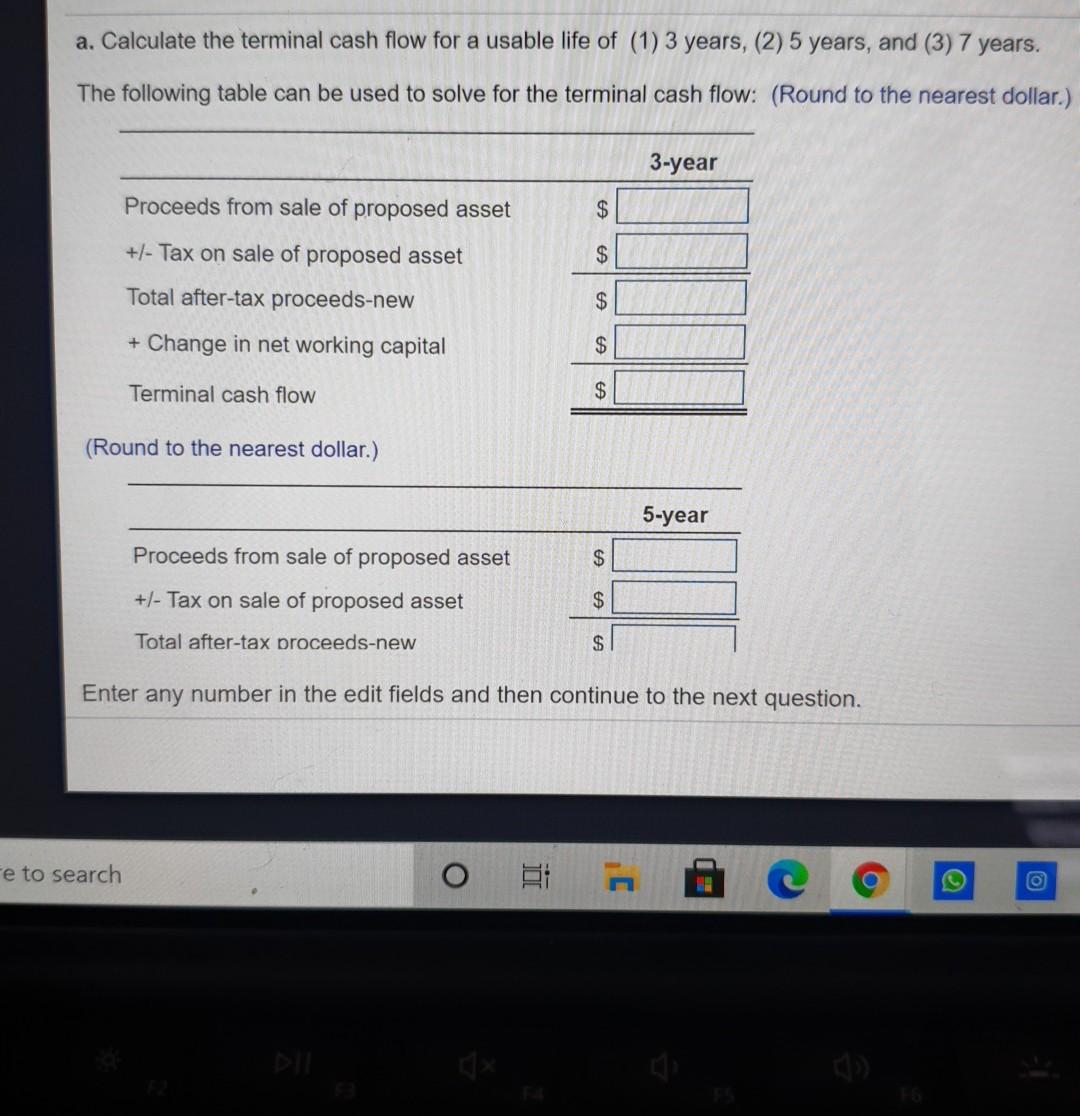
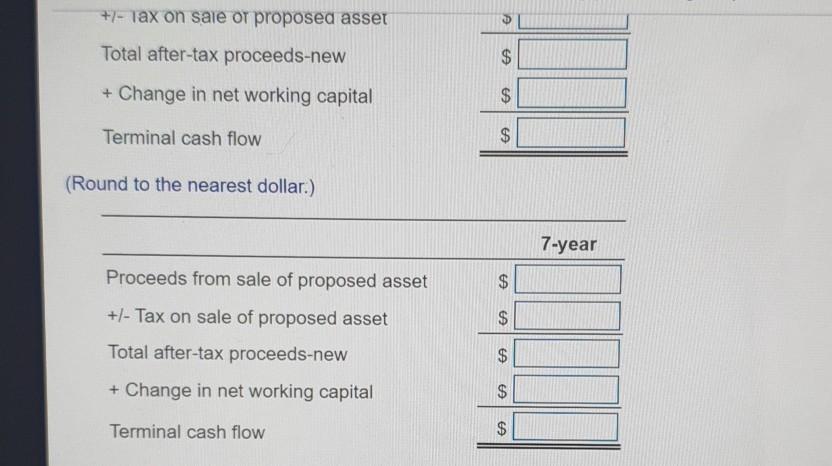
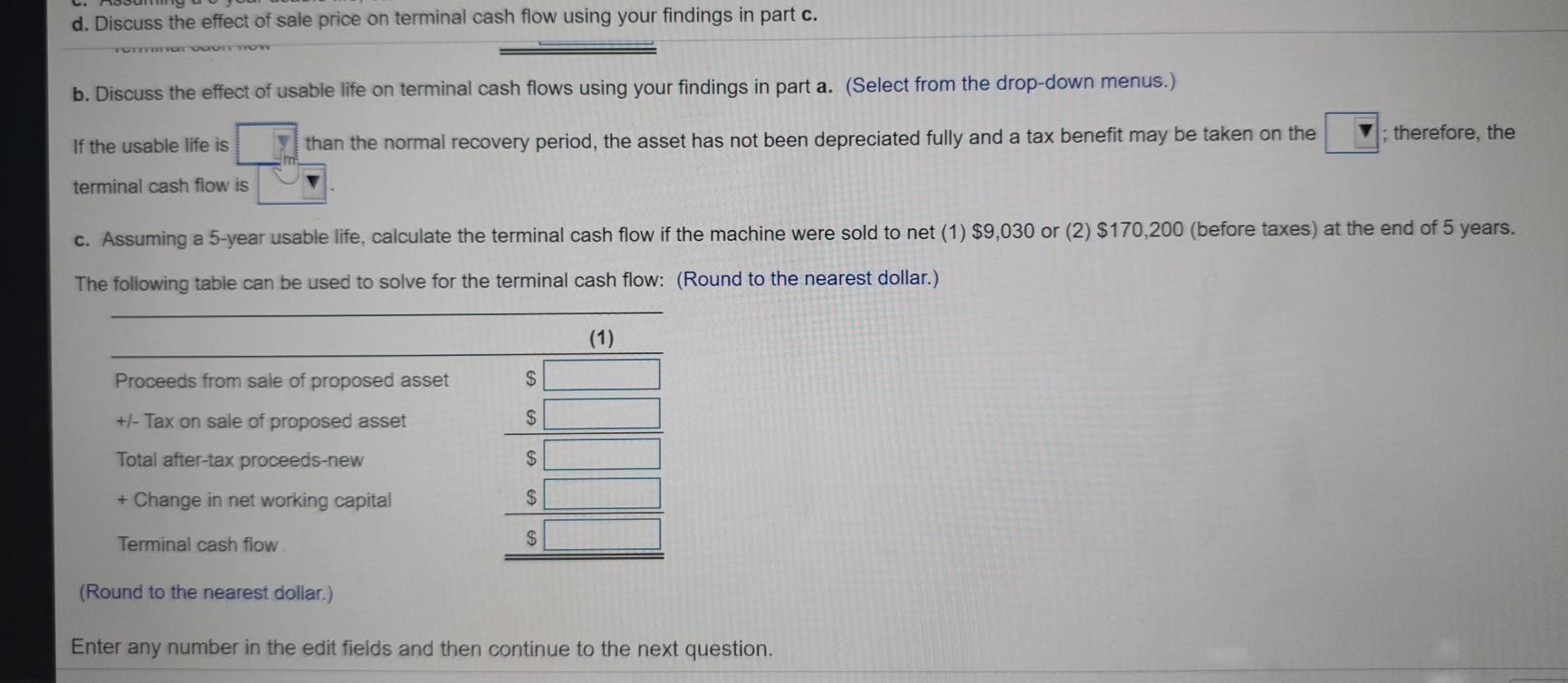
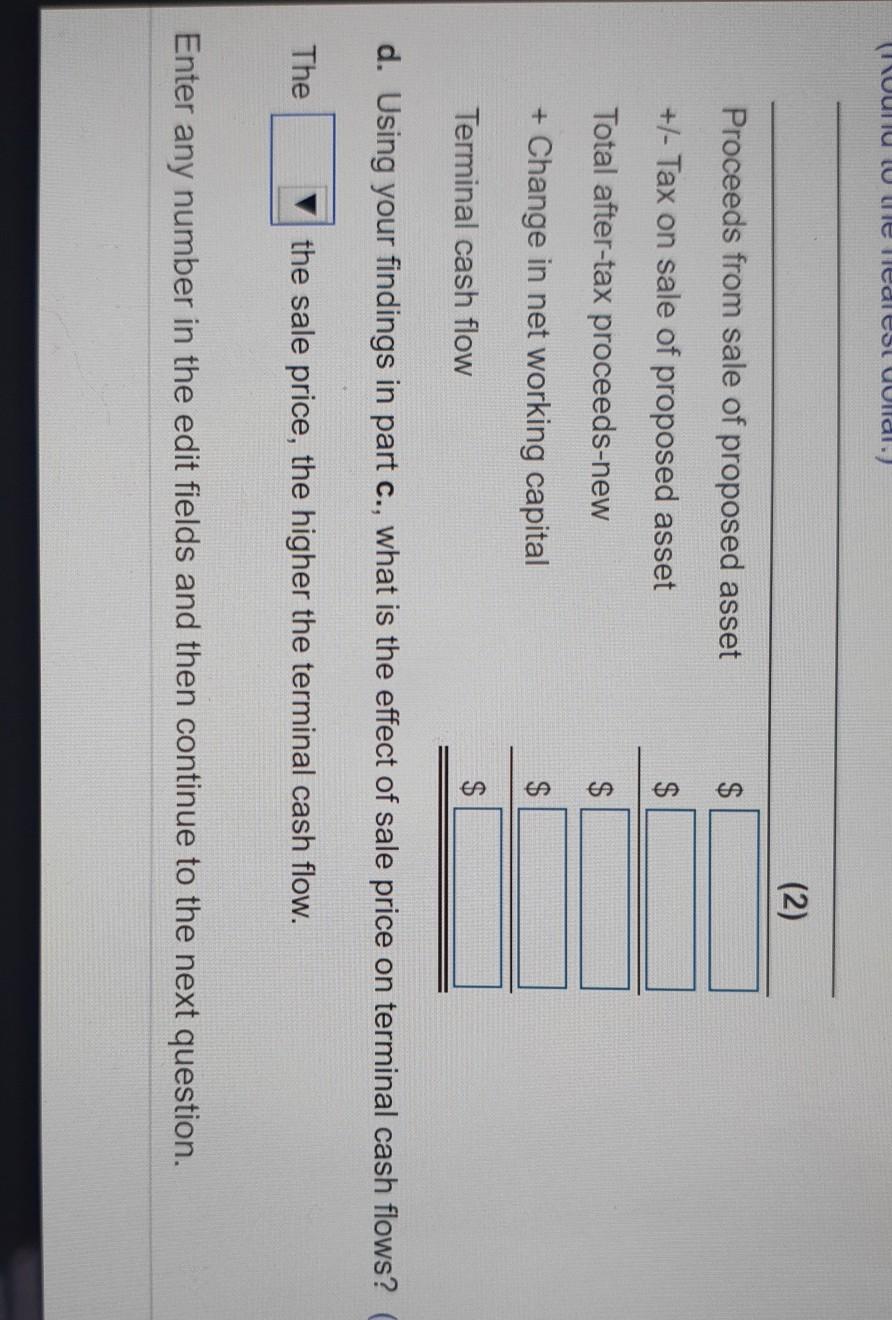
e of (Click on the icon here in order to copy the contents of the data table below into a spreadsheet.) prod het w flow rest m sal e of Rounded Depreciation Percentages by Recovery Year Using MACRS for First Four Property Classes Percentage by recovery year* Recovery year 3 years 5 years 7 years 10 years 33% 20% 14% 10% 2 45% 32% 25% 18% 3 15% 19% 18% 14% 4 7% 12% 12% 12% 5 12% 9% 9% 6 5% 9% 8% 7 9% 7% 8 4% 6% 9 6% 10 6% 11 4% Totals 100% 100% 100% 100% *These percentages have been rounded to the nearest whole percent to simplify calculations while retaining realism. To calculate the actual depreciation for tax purposes, be sure to apply the actual unrounded percentages or directly apply double-declining balance (200%) depreciation using the half-year convention. prog in a. Calculate the terminal cash flow for a usable life of (1) 3 years, (2) 5 years, and (3) 7 years. The following table can be used to solve for the terminal cash flow: (Round to the nearest dollar.) 3-year $ Proceeds from sale of proposed asset +/- Tax on sale of proposed asset Total after-tax proceeds-new $ $ + Change in net working capital $ Terminal cash flow $ (Round to the nearest dollar.) 5-year Proceeds from sale of proposed asset $ +/- Tax on sale of proposed asset $ Total after-tax proceeds-new $ Enter any number in the edit fields and then continue to the next question. e to search O e +- Tax on sale or proposed asset Total after-tax proceeds-new + Change in net working capital $ Terminal cash flow $ (Round to the nearest dollar.) 7-year $ Proceeds from sale of proposed asset +/- Tax on sale of proposed asset Total after-tax proceeds-new $ $ + Change in net working capital $ Terminal cash flow $ d. Discuss the effect of sale price on terminal cash flow using your findings in part c. w b. Discuss the effect of usable life on terminal cash flows using your findings in part a. (Select from the drop-down menus.) ; therefore, the If the usable life is than the normal recovery period, the asset has not been depreciated fully and a tax benefit may be taken on the terminal cash flow is C. Assuming a 5-year usable life, calculate the terminal cash flow if the machine were sold to net (1) $9,030 or (2) $170,200 (before taxes) at the end of 5 years. The following table can be used to solve for the terminal cash flow: (Round to the nearest dollar.) Proceeds from sale of proposed asset $ +|- Tax on sale of proposed asset $ $ Total after-tax proceeds-new + Change in net working capital $ Terminal cash flow $ (Round to the nearest dollar.) Enter any number in the edit fields and then continue to the next question. (oui oule lediest collal.) (2) Proceeds from sale of proposed asset $ +/- Tax on sale of proposed asset $ Total after-tax proceeds-new $ + Change in net working capital $ Terminal cash flow d. Using your findings in part c., what is the effect of sale price on terminal cash flows? The the sale price, the higher the terminal cash flow. Enter any number in the edit fields and then continue to the next question. e of (Click on the icon here in order to copy the contents of the data table below into a spreadsheet.) prod het w flow rest m sal e of Rounded Depreciation Percentages by Recovery Year Using MACRS for First Four Property Classes Percentage by recovery year* Recovery year 3 years 5 years 7 years 10 years 33% 20% 14% 10% 2 45% 32% 25% 18% 3 15% 19% 18% 14% 4 7% 12% 12% 12% 5 12% 9% 9% 6 5% 9% 8% 7 9% 7% 8 4% 6% 9 6% 10 6% 11 4% Totals 100% 100% 100% 100% *These percentages have been rounded to the nearest whole percent to simplify calculations while retaining realism. To calculate the actual depreciation for tax purposes, be sure to apply the actual unrounded percentages or directly apply double-declining balance (200%) depreciation using the half-year convention. prog in a. Calculate the terminal cash flow for a usable life of (1) 3 years, (2) 5 years, and (3) 7 years. The following table can be used to solve for the terminal cash flow: (Round to the nearest dollar.) 3-year $ Proceeds from sale of proposed asset +/- Tax on sale of proposed asset Total after-tax proceeds-new $ $ + Change in net working capital $ Terminal cash flow $ (Round to the nearest dollar.) 5-year Proceeds from sale of proposed asset $ +/- Tax on sale of proposed asset $ Total after-tax proceeds-new $ Enter any number in the edit fields and then continue to the next question. e to search O e +- Tax on sale or proposed asset Total after-tax proceeds-new + Change in net working capital $ Terminal cash flow $ (Round to the nearest dollar.) 7-year $ Proceeds from sale of proposed asset +/- Tax on sale of proposed asset Total after-tax proceeds-new $ $ + Change in net working capital $ Terminal cash flow $ d. Discuss the effect of sale price on terminal cash flow using your findings in part c. w b. Discuss the effect of usable life on terminal cash flows using your findings in part a. (Select from the drop-down menus.) ; therefore, the If the usable life is than the normal recovery period, the asset has not been depreciated fully and a tax benefit may be taken on the terminal cash flow is C. Assuming a 5-year usable life, calculate the terminal cash flow if the machine were sold to net (1) $9,030 or (2) $170,200 (before taxes) at the end of 5 years. The following table can be used to solve for the terminal cash flow: (Round to the nearest dollar.) Proceeds from sale of proposed asset $ +|- Tax on sale of proposed asset $ $ Total after-tax proceeds-new + Change in net working capital $ Terminal cash flow $ (Round to the nearest dollar.) Enter any number in the edit fields and then continue to the next question. (oui oule lediest collal.) (2) Proceeds from sale of proposed asset $ +/- Tax on sale of proposed asset $ Total after-tax proceeds-new $ + Change in net working capital $ Terminal cash flow d. Using your findings in part c., what is the effect of sale price on terminal cash flows? The the sale price, the higher the terminal cash flow. Enter any number in the edit fields and then continue to the next
Step by Step Solution
There are 3 Steps involved in it
Step: 1

Get Instant Access to Expert-Tailored Solutions
See step-by-step solutions with expert insights and AI powered tools for academic success
Step: 2

Step: 3

Ace Your Homework with AI
Get the answers you need in no time with our AI-driven, step-by-step assistance
Get Started


